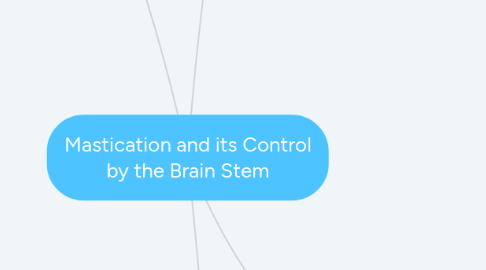
1. SENSORY FEEDBACK
1.1. Most types of low threshold mechanoreceptors are phasically stimulated at the start of or during slow closing phase.
1.2. 1. Epithelial Mechanoreceptor Afferents
1.2.1. Mandibular division of Gasserian (V) ganglion
1.2.2. Hair: 60% were excited during mastication & proportional to velocity of movement
1.2.3. Mucosal: touch at lip
1.2.4. Skin: most not active, touch at lip
1.3. 2. Periodontal Afferents
1.3.1. Mechanoreceptors: activated by biting and mastication
1.3.1.1. 1) cell bodies in V ganglion: molar teeth & rapidly adapting
1.3.2. 2) cell bodies in trigeminal mesencephalic nucleus: incisor teeth & apical regions of PDL & slowly adapting
1.4. 3. Temporomandibular Joint Afferents
1.4.1. cell bodies in mandibular division of V ganglion
1.4.2. Not active when jaw was at rest
1.4.3. respond best to movements that stretched the part of capsule
1.5. 4. Muscle Afferents
1.5.1. 4.1. Spindle Afferents
1.5.1.1. Very active during slow closing phase, also fire strongly during jaw opening
1.5.1.2. cell bodies in trigeminal mesencephalic nucleus
1.5.1.3. 1. primary afferents: short bursts up to 600 Hz at start of jaw opening
1.5.1.4. 2. secondary afferents: most active (80 to 200 Hz) at end of opening
1.5.2. 4.2. Golgi Tendon Organs and Other Afferents
1.5.2.1. indicator of muscle tension
1.5.2.2. trigeminal mesencephalic nucleus
2. ACTIVATION OF AFFERENTS
2.1. 1. Tonic Stimulation
2.1.1. Tonic afferent input can initiate mastication and keeps the movements going
2.1.2. Periodontal & mucosal afferents --> initiate mastication and fictive mastication
2.1.3. Muscle spindle afferents --> not initiate fictive mastication
2.1.4. Tonic pressure onmaxillary incisor --> lateral jaw reflex & mandible swings to contralateral side
2.1.5. Pressure on teeth is too strong = noxious --> mastication stops
2.2. 2. Phasic Stimulation
2.2.1. 2.1. Epithelial Afferents
2.2.1.1. 1) Modulation of the Jaw-Opening Reflex
2.2.1.1.1. Low-threshold mechanoreceptor afferents phasic mechanical stimulation & electrical stimulation of V nerve --> jaw-opening reflex (JOR)
2.2.1.1.2. Reflex was facilitated during jaw opening & inhibited during closure
2.2.1.2. 2) Modulation of the Masticatory Pattern
2.2.1.2.1. Duration of the masticatory cycle
2.2.2. 2.2. Periodontal Afferents
2.2.2.1. positive feedback to the jaw-closing muscles
2.2.2.2. 1) Modulation of the Jaw-Opening Reflex
2.2.2.2.1. Caused by hard taps to the teeth: hard foods
2.2.2.2.2. First cycle of the reduction series: during slow closing phase
2.2.2.3. 2) Modulation of the Masticatory Pattern
2.2.2.3.1. during slow closing phase & longer cycle & mandible swing toward contralateral
2.2.2.3.2. Action of periodontal inputs on jaw-closer muscle burst changes from inhibition to excitation at transition from preparatory to reduction series of movements
2.2.3. 2.3. Muscle Spindle Afferents
2.2.3.1. positive feedback to the jaw-closing muscles
2.2.3.2. When food or an artificial substance stops or slows movement during slow closing phase, muscle spindle afferents & periodontal afferents are stimulated
3. REMOVAL OF AFFERENT INPUTS
3.1. Rhythmical activation of various muscle groups involved in mastication is generated by a CPG in brain stem.
3.2. Sensory feedback, from intraoral mechanoreceptors, modifies the basic pattern and is particularly important for the proper coordination of tongue, lips, and jaws.
3.3. 1. Selective Deafferentation: blockage of transmission in sensory nerves
3.3.1. This did not stop mastication
3.3.2. Masticatory movements were more irregular
3.4. 2. Paralysis: the Fictive Pattern -- prevention of movement
3.4.1. "fictive movements" : absence of movement that have motor patterns by central pattern generators (CPG)
4. BRAIN STEM ELEMENTS
4.1. Central pattern of mastication generated in 2 stages: 1. rhythm by neurons in the midline reticular formation & 2. bursts by premotor neurons near motor nuclei
4.2. Cortex exerts its action on the brain stem CPG --> corticobulbar tracts & projection is mainly contralateral
4.3. 1. Central Pattern Generator
4.3.1. CPG modulates primary afferents & interneurons in order to suppress unwanted reflexes and to favor those that enhance motor performance
4.3.2. Isolated brain stem had the ability to generate the basic features of mastication & Mesencephalic RF projects contralaterally to CPG through nonpyramidal pathway.
4.3.3. 1.1. Rhythm Generation
4.3.3.1. two rhythm generators can function independently
4.3.4. 1.2. Burst Generation
4.3.4.1. Burst generators excite the opener alpha motoneurons and inhibit the closers during the opening phase
4.3.4.2. 1) Inhibition of Closer Motoneurons
4.3.4.2.1. Inhibition of jaw-closer muscle activity occurs before digastric becomes active in the first opening movement and has lower cortical threshold than opener burst.
4.3.4.2.2. cannot be initiated by reciprocal inhibition
4.3.4.3. 2) Generation of Opener Bursts
4.3.4.3.1. Many of interneurons involved in the jaw-opening reflex are normally outside the burst generator
4.3.4.4. 3) Generation of Closer Bursts
4.3.4.4.1. pressure on teeth or gingivae activated units in caudal parts of nucleus, and that a few had convergent inputs for spindles and oral mechanoreceptors
4.4. 2. Control of Motoneurons by the CPG
4.4.1. 2.1 Alpha Motoneurons
4.4.1.1. extrafusal muscle fibers & directly control contraction of muscle
4.4.1.2. rhythmic IPSPs
4.4.2. 2.2 Gamma Motoneurons
4.4.2.1. intrafusal fibers & slowly & smaller cell bodies
4.4.2.2. 1) static fusimotor neurons
4.4.2.2.1. phasically excited during jaw closure
4.4.2.3. 2) dynamic fusimotor neurons
4.4.2.3.1. tonically active during mastication
4.5. 3. Control of Interneurons and Primary Afferents by the CPG
4.5.1. Functions of CPGs: 1. adjust the gain of reflexes, 2. suppress those that are unnecessary, and 3. facilitate those that enhance motor performance
4.5.2. CPGs control through the fusimotor system & direct action on alpha motoneurons (e.g., slow IPSPs)
4.5.3. 3.1 Neurons with Cortical Inputs
4.5.3.1. Parts of the brain stem that contain the labeled V premotor neurons can be excited by cortical stimulation.
4.5.4. 3.2 Neurons with Low-Threshold Orofacial Inputs
4.5.4.1. low-threshold inputs --> inhibited digastric jaw-opening reflex & interneurons on this reflex arc be tonically inhibited by the CPG
4.5.5. 3.3 Neurons with High-Threshold Orofacial Inputs
4.5.5.1. CPG increases the excitability of the high threshold interneurons during closure.
4.5.6. 3.4 Primary Afferents
4.5.6.1. hyperpolarized during the jaw-opening phase & depolarized during the closing phase of fictive mastication.
4.5.6.2. CPG has at least two ways of controlling muscle spindle primary afferents during mastication
4.5.6.2.1. 1. through the fusimotor system
4.5.6.2.2. 2. synaptic action of the CPG on trigeminal mesencephalic nucleus
